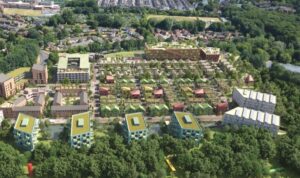Two-thirds of UK residents feel that too much focus is being placed solely on the construction of new homes, as opposed to creating rounded communities with supporting infrastructure, a new report has found.
The Future Communities Report has been published by Eurocell and it draws on the findings of a survey of 1,000 UK adults with an equal split between homeowners, private renters and social housing occupants.
The report also includes expert input from architects at leading studios BDP, Stanton Williams, Urbanist Architecture and TOWN. It reveals insight into the communities that people hope to live in and current trends in the built environment sector.
Almost seven in 10 (69%) of respondents said that they felt not enough consideration is given to the provision of educational, health and sports facilities during the current planning process for homes.
A further 32% of people believe that not enough has been done to support the development of doctors, dentists and hospitals, with another 31% saying that not enough had been done to support the development of schools and nurseries. Respondents also said that not more should be done to provide parks (28%), leisure facilities such as sports and craft centres (26%) and amenities such as cafes (21%).
As a result of this, 55% of respondents said that they felt that quickly building a high volume of homes negatively impacts community spirit. In addition, 44% identified a failure to extend existing services (for example, doctors’ surgeries and schools) to allow for an increase in the number of residents as having the biggest impact on the integrations of new and old communities.
When asked to identify the top factors in ensuring that enough supporting infrastructure is developed in the communities of the future, 37% highlighted providing more opportunities for local residents to input on planning decisions while 36% said there was a greater need for collaboration between planners and service providers.
Other factors highlighted included more focus on the design and build of multi-use buildings (31%), more powers over services being passed to local government for better local oversight (27%), and more strategic leadership at a national level (22%.)
Fanis Anastasiadis, architect director at Urbanist Architecture, highlighted: ‘You now have a planning section before you even do the visual developments. This should involve the community from the start to identify needs and allocate them throughout the available map and make sure that the community has a clear view and goal for where they want to go and how people want to live in the future.’

















Leave a Reply